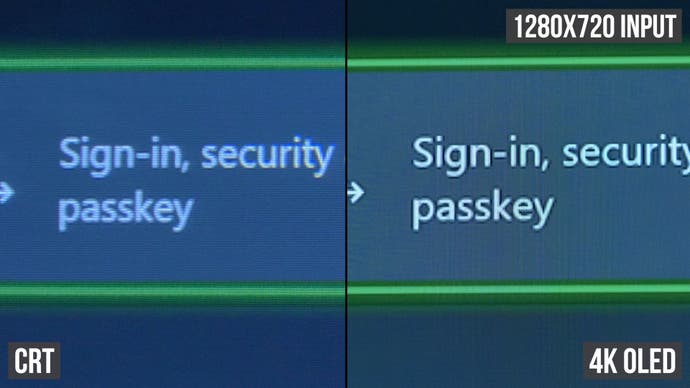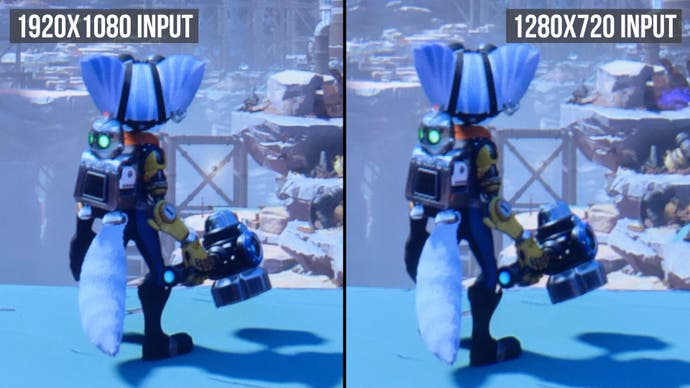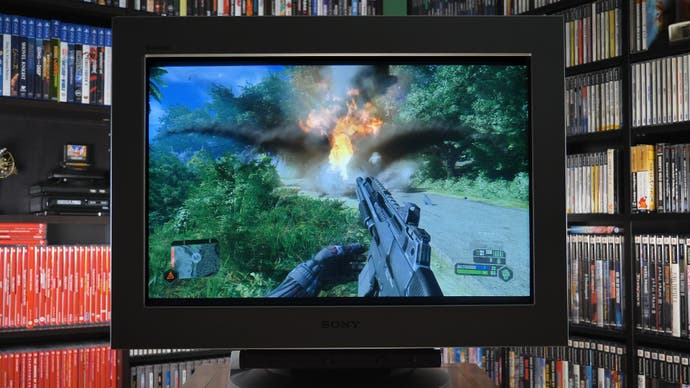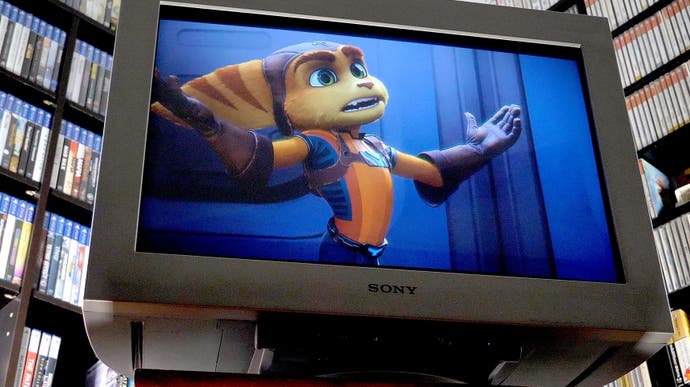PlayStation 5 and Series X tested on a CRT - a game-changer for image quality?
Sony's legendary FW900 looks amazing but modern screens have charms of their own.
In the past, Digital Foundry has enthused about the quality of high-end CRTs, the display technology of yesteryear that can still deliver some aspects of image quality that no modern screen can match. We've talked about contrast, precision, motion resolution and much more. Now, two years on from us acquiring the Sony GDM-FW900 - quite possibly the best gaming CRT money can buy - we've tested out how the display works with the new wave of consoles: Xbox Series X and PlayStation 5. Are all of the benefits of CRT still there? How on earth do you connect an HDMI device to an 18-year-old display? How does today's 4K rendering stand up on a CRT screen? And since we first looked at CRTs, have modern displays made any strides in matching up to the strengths of the cathode ray experience?
You can see for yourself by checking out the video below, where I test out a range of PlayStation 5 and Xbox Series X games on my own FW900 and show off how the latest OLED screens from LG are able to compete against one of the key strengths of CRT - but first of all, let's go back to basics. What makes the FW900 so special? Put simply, it's Sony deploying its Trinitron tech to maximum effect, with a relatively large 24-inch 16:10 screen. It's able to process virtually resolution up to 2560x1600 at 60Hz, and if you scale down resolution, it's possible to increase frequency - so yes, high refresh rate gaming is possible. The downsides? A 24-inch screen is small by today's standards, but the FW900 is a huge, desk dominating box, and it weighs 42kg, meaning it is hardly portable.
Inputs are via VGA or BNC, where five sockets allow for individual connection of red, green, blue signals along with horizontal and vertical sync. In terms of connecting a modern device, HDMI to VGA adapters are possible and achieving 1080p60 is possible even with cheapo adapters. We've tested a Vention box from Amazon UK (US link here), which seems to allow for 1440p60 too. USB-C and DisplayPort adapters are also available which will get the job done for PC users.
At this point I think it's worth stressing that the primary use-case scenario for CRTs remains in the retro gaming space - and while Sony's high-end broadcast monitors offer the best possible experience, good consumer level TVs still look wonderful. PC CRT monitors are mostly using a 4:3 aspect ratio, so won't be entirely suitable for modern gaming, but still work beautifully for older games, particularly when classic DOS games could target 70Hz refresh rates, causing problems when running on the most common screens of today.

But in our tests here, the FW900 proved stunning in running Xbox Series X and PlayStation 5 games - even downscaled to 1080p. That's the first key advantage of CRT technology: the concept of native resolution isn't really relevant to this technology. Yes, there are resolution limits set by the aperture grill or shadow mask, but input resolution is always resolved with no scaling. Modern monitors have a fixed pixel grid structure and if you aren't at native res, ugly interpolation is involved in the upscaling process. CRTs go about things in an entirely different way. An electron gun at the neck of the tube sends out beams of electrons directed by an anode through a mesh (a shadow mask or aperture grill) before striking the phosphor-coated screen, lighting the final image.
The end result is very different to the modern fixed grid approach: if you opt for extra resolution, this can add detail (check out the Ratchet comparison image below), but the point is that liberated from the concept of native resolution, a CRT with downscaled 4K content still looks stunning, even at 720p - because the way in which CRTs literally 'beam out' information changes the user's perception of detail and resolution. This is the reason why developers are tackling the challenge of 4K rendering through the use of image reconstruction - to mitigate the majority of the issues of modern upscaling by attempting to get as close as possible to a 4K image without the screen's upscaling kicking in.

The other key advantage of CRT is motion resolution. Modern displays use a system called sample and hold, which drops displayed resolution significantly when the content is in motion. Remember how blurry football matches looked moving left to right on the earliest LCD and plasma displays? That's the most egregious example of sample and hold's problems. The situation has improved over time, but there's still a dramatic drop in motion resolution even in the most modern screens. The native of CRT's technology ensures that this is a non-issue. The good news is that strides are being made here and we are getting very, very close to CRT quality thanks to blank frame insertion, known as Motion Pro on LG screens. By strobing quickly between content and a black frame, the artefacts of sample and hold are mitigated. LG's 2020 and 2021 OLED screens with Motion Pro are getting very, very close to matching CRT's motion quality - the minus point being a dimmer look to the content owing to the black frame strobe. Beyond that, the good news is that other display manufacturers are offering their own solutions, albeit with varying levels of effectiveness.
So with our CRT testing with PlayStation 5 and Series X complete, what have we learned? Well, as fascinating as it is and as fantastic as the results are, modern day gaming on a CRT is very much a niche endeavour - the Sony GDM-FW900 works beautifully because it is a widescreen display and it's relatively easy to convert HDMI across to work with it. In terms of a precision look, with astonishing contrast and a crystal-clear image, it is still peerless - but it's not living room friendly to say the least, and if you do spend thousands to get one, the chances are you'll need to put the screen through an extensive calibration process to get the best results from it. It's not easy. The truth is that the popularity of CRTs with enthusiast gamers is very much in the retro space and that is very definitely the best fit for this kind of technology - the games machines and the titles on them were specifically designed for this technology.


And the good news is that modern displays are improving - dramatically so. OLED looks beautiful, screen sizes are getting larger and prices are getting cheaper. Meanwhile, it's gaming that's driving the feature set and making these screens better - and it's all paying off with HDMI 2.1. High refresh 120Hz is codified as a standard in most new living room displays, right up to 4K support. Auto low latency modes are ensuring that games bypass the lag-inducing processing found on many screens, while we're seeing the arrival of genuinely game-changing features too - like variable refresh rate support for example - not to mention black frame insertion. We're never going to go back to the CRT era, but there's still something very special about gaming on the FW900 - something unique and wonderful and something we've lost in the modern era.


